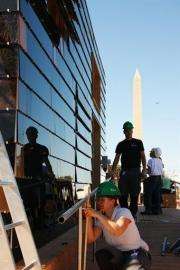US Solar Decathlon seeks best sun-powered homes

For the past week on the National Mall in Washington, international crews have been busy putting up structures for an event showcasing a radiant source of energy that some once revered as a god.
No, it is not a remake of President Barack Obama's inauguration but the Solar Decathlon, a biennial event that begins Thursday and this year puts modular, solar-powered homes through 10 tests to determine which is the new sun king.
Over the course of a week, teams of students from Canada, Germany, Spain and the United States will take part in competitions judging the houses they designed and built for everything from aesthetics to engineering to whether the water heating system can meet a couple's hot water needs.
Judges will determine whether the houses are properly fitted out with the modern conveniences most Westerners cannot live without, and whether the appliances consume less energy than those in the average US home.
The houses displayed on the Mall, the sprawling grassy esplanade between the US Capitol and the Washington Monument, are restricted to a footprint of 800 square feet (74.3 square meters) and are supposed to target a specific market.
Scores of teams applied to compete in this year's decathlon, but only 20 were accepted, including Team Beausoleil from the University of Louisiana, which built a house inspired by Cajun culture and facts of life in the southern US state, such as hurricanes.
The 5.5-inch (14-centimeter) insulated walls can resist winds of 130 miles (209 kilometers) per hour, and the insulation would also "cut your energy rate by about half if the house's solar panels were not producing for the home," said Catherine Guidry, one of the students working on the home.
The house featured a porch -- almost a requirement in laid-back Louisiana -- with moveable doors so it can be closed off on all sides or open on two sides. Plants indigenous to Louisiana thrived in planters in the small garden.
"We wanted it to feel like Louisiana from the inside and outside," Guidry told AFP.
Team Germany, winner of the 2007 decathlon, has reconstructed a house whose exterior walls and louvered windows are covered with small integrated solar panels.
Like the Spanish team's abode, which features a large, raised moveable solar panel on the roof, the house was shipped across the Atlantic Ocean for the competition.
The entry from Cornell University students in New York state features three corrugated steel cylinders and walls insulated with five inches of soy-based foam and sky-lights in all three cylindrical rooms.
The house is visually striking and, according to Cornell architecture student Chris Werner, can hold its own in a new category in this year's decathlon -- the "net metering" contest, which measures the energy a house produces for or takes from the electricity grid during the competition.
Even the heat that gets trapped in the structure's steel exterior is used to heat water, said Werner.
And when Cornell put its house through its paces at last month's New York state fair, it achieved "net-zero or better the entire time," meaning it is efficient enough to not require energy from the grid, according to Werner.
After two years of work on their houses plus nearly two weeks of constructing and competing, the winners will take home "bragging rights and lots of good feelings about the last two years of our lives," he said.
They will also take home a little culinary insight into the regions represented by other competitors because the "home entertainment" category of the decathlon requires teams to cook dinner for members of rival line-ups.
The German team's menu will feature dumplings known as knoedeln, but no sauerkraut, said Sardika Meyer, a spokeswoman for the team.
No German beer either -- alcohol is banned at the competition.
The University of Arizona team, whose house is made up of four modules that look like glass-domed funicular railway cars, plans to treat guests to tamales -- the Mexican answer to chapatis -- filled with dried, shredded beef known as "machaca" and a cactus salsa.
And Team Beausoleil will serve up Louisiana specialties, including gumbo and bread pudding -- but has ditched the idea of serving fried alligator.
"We thought it might scare away the neighbors," said Geoff Gjertson, the team's faculty advisor.
(c) 2009 AFP


















